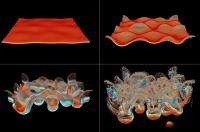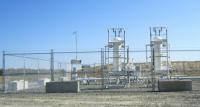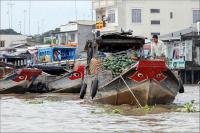-
Governor Brown issues order to continue water savings as drought persists
Moving to bolster California’s climate and drought resilience, Governor Edmund G. Brown Jr. the other day issued an executive order that builds on temporary statewide emergency water restrictions to establish longer-term water conservation measures. The governor’s office says that Californians have responded to the call to conserve water during the drought by dialing back sprinklers, replacing lawns, fixing leaky faucets, and installing more efficient toilets and washing machines. Between June 2015 and March 2016, Californians reduced water use by 23.9 percent compared with the same months in 2013 — saving enough water to provide 6.5 million Californians with water for one year.
-
-
Floods, coastal erosion may expose contents of UK landfills
The contents of historic coastal landfill sites in England and Wales could pose a significant environmental threat if they erode, according to a new study. The main risks to these landfills come from the effects of climate change, including erosion and flooding with salt water from storm surges and higher water levels.
-
-
Mapping water use of America’s water resources
Water is one of our nation’s most important natural resources, one that is long been considered inexhaustible. Yet changes in land use, climate, and population demographics are placing unprecedented demands on America’s water supplies. As droughts rage and aquifers dwindle, people may wonder: Is there enough water to meet all our needs?
-
-
Marine Corps, Sandia collaborate on microgrids and renewable energy planning
The U.S. Marine Corps are the first boots on the ground in a crisis. On the front lines, they must be able to power up securely without plugging into utilities. They require nothing less than completely reliable and cost-effective energy independence. Researchers from Sandia National Laboratories are collaborating with the Marine Corps to increase their energy security and reduce fuel dependence through alternative technologies, including renewable energy and microgrids.
-
-
Protecting Texas electrical grid key to preserving national security
Protecting America’s most vulnerable asset – our electric power grid – starts with Texas, according to a new study. “As Texas goes, so goes our national security,” says the study’s author. “Outside of California and the Beltway, Texas is arguably the most important state for defense readiness.” Hardening the state’s electric power grid should be top priority.
-
-
“Internet of Things” increases threat to infrastructure
According to former Director of National Intelligence Dennis Blair, a simple Web search can reveal information from thousands of unsecured devices. Even the casual browser can access camera data from Sweden, video game server activity in Eastern Europe, or the output of American wind turbines. He said this information is as easily accessible to terrorists and other criminals. And more will become available as the “Internet of things” — the collection of physical systems and devices connected to the Internet — grows in size.
-
-
Climate-driven water scarcity could reduce economic growth by up to 6%: World Bank
Water scarcity, exacerbated by climate change, could cost some regions up to 6 percent of their GDP, spur migration, and spark conflict, according to a new World Bank report released the other day. The report says the combined effects of growing populations, rising incomes, and expanding cities will see demand for water rising exponentially, while supply becomes more erratic and uncertain.
-
-
Fixing NYC’s aging infrastructure one engineering problem at a time
How do you make sure aging bridges which are vital links in New York City’s transportation network are safe or keep the city’s sewer system from breaking down? These are among the questions that occupy Columbia University researchers, who have installed sensors to analyze vibration on some of the city’s bridges and in landmark buildings and museums, and have focused on the functioning of the city’s water system.
-
-
More corrosion-resistant water pipes could preventing another Flint, Mich. health crisis
Corrosion-related damage costs more than three percent of the United States’ Gross Domestic Product (about $503.1 billion, going by 2013 numbers). With documented public water problems in Flint, Michigan, and Hoosick Falls, New York, caused by corrosion, understanding how copper is affected at the atomic level is critical to avoiding problems in future pipes.
-
-
Turbulent mixing research makes advanced thermal reactors safer

Researchers are working to make advanced thermal reactors safer by establishing trusted uncertainty guidelines regarding advanced reactor turbulent mixing processes. “The overall goal of this project is the efficient management of heat transfer and being able to predict what’s going to happen in accident scenarios from a thermal hydraulics standpoint,” one researcher said. “A lot of what I’m doing in this research is focused on establishing uncertainty in the predictive tools that we have for measuring those accident scenarios.”
-
-
Repairing earthquake-damaged bridge columns in days, not weeks
In just thirty seconds, a devastating earthquake like the ones that struck Japan and Ecuador can render a city helpless. With roadways split and bridges severely damaged, residents and emergency personnel could be prevented from moving around to rebuild. Normally, it takes weeks to repair the cracking or spalling of columns on just one bridge damaged in an earthquake. Researchers have developed a new process of fixing columns that takes as little as a few days.
-
-
Fracking would pose no danger to water supplies: Research

One of the primary concerns of those who oppose the development of shale gas by hydraulic fracturing is that creation of new fractures in the earth could cause fracking fluids to leak into, and contaminate, underground freshwater aquifers. Potential future fracking activity in the United Kingdom is unlikely to pose a pollution danger to overlying aquifers, new research from a leading academic suggests.
-
-
Putting consistent value on experts' uncertainty on climate change models
Science can flourish when experts disagree, but in the governmental realm uncertainty can lead to inadequate policy and preparedness. When it comes to climate change, it can be OK for computational models to differ on what future sea levels will be. The same flexibility does not exist for determining the height of a seawall needed to protect people from devastating floods. For the first time in the climate field, researchers have combined two techniques long used in fields where uncertainty is coupled with a crucial need for accurate risk-assessment — such as nuclear energy — in order to bridge the gap between projections of Earth’s future climate and the need to prepare for it.
-
-
What we learned from Chernobyl about how radiation affects our bodies
The world has never seen a nuclear accident as severe as the one that unfolded when a reactor exploded in Chernobyl on 26 April 1986, sending vast amounts of radiation into the skies around Ukraine, Belarus and Russia. The planet had experienced massive releases like this before, in the bombings of Hiroshima and Nagasaki in 1945. But Chernobyl-related radiation exposure had a more protracted character. It was the first time in history that such a large population, particularly at a very young age, was exposed to radioactive isotopes, namely iodine-131 and cesium-137, not just through direct exposure, but through eating contaminated food as well.
-
-
Rising seas put Vietnam in the “bull’s eye” of rising seas

A rising sea level — for a country like Vietnam, with 2,000 miles of coastline — presents a major environmental and food security challenge, especially in the Mekong River Delta region where 22 percent of the population lives and about half of the country’s food is produced.
-
More headlines
The long view
Helping Strengthen America’s Critical Infrastructure
Everyday life depends on a robust infrastructure network that provides access to running water, communications technology and electricity, among other basic necessities. The experts who keep our national infrastructure secure and resilient also need a strong network to share their knowledge and train the next generation of professionals capable of solving complex infrastructure challenges.
AI and the Future of the U.S. Electric Grid
Despite its age, the U.S. electric grid remains one of the great workhorses of modern life. Whether it can maintain that performance over the next few years may determine how well the U.S. competes in an AI-driven world.
Using Liquid Air for Grid-Scale Energy Storage
New research finds liquid air energy storage could be the lowest-cost option for ensuring a continuous power supply on a future grid dominated by carbon-free but intermittent sources of electricity.
Enhanced Geothermal Systems: A Promising Source of Round-the-Clock Energy
With its capacity to provide 24/7 power, many are warming up to the prospect of geothermal energy. Scientists are currently working to advance human-made reservoirs in Earth’s deep subsurface to stimulate the activity that exists within natural geothermal systems.
Experts Discuss Geothermal Potential
Geothermal energy harnesses the heat from within Earth—the term comes from the Greek words geo (earth) and therme (heat). It is an energy source that has the potential to power all our energy needs for billions of years.
